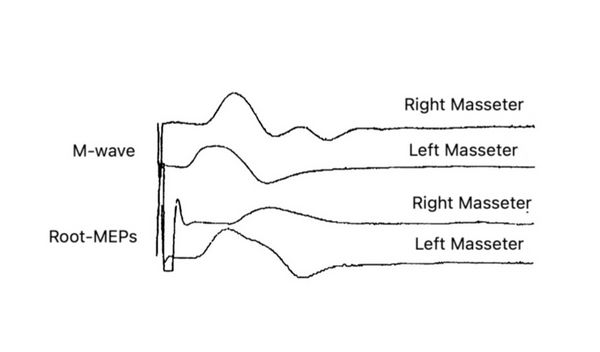Difference between revisions of "1° Clinical case: Hemimasticatory spasm"
| Line 23: | Line 23: | ||
Basically, given the compatibility and consistency of sentence {{:F:Imo}} (dental context) with the assertions derived from the clinical test reporting {{:F:Delta series}}, consistently say that Orofacial Pain is caused by a Temporomandibular Disorder could become incompatible if another set of clinical statements <math>(\gamma_1,\gamma_2,.....\gamma_n \ )</math> were consistent with sentence <math>\Im_n</math> (neurological context) and contextually opposite, from a diagnostic point of view, to {{:F:Imo}}<blockquote>Therefore, there would be a source of logistical conflict between the two specialist contexts with inevitable diagnostic delay, also polluting the decryption process of the signal in the machine language of the Central Nervous System (CNS).</blockquote>What will determine the access key for decoding the encrypted code in machine language (SNC) and will allow us to intercept a demarcation line will be an irrefutable clinical and / or laboratory data called {{:F:Tau}}, which will confirm or exclude the consistency of an assertion than the other. It is essential, at this point, a <math>\Im_d</math> sentence (demarcation sentence) of the type will be: <blockquote>Does Mary Poppins have a neuromotor disorder or a Temporomandibular Disorder? </blockquote>We explain this step in detail: | Basically, given the compatibility and consistency of sentence {{:F:Imo}} (dental context) with the assertions derived from the clinical test reporting {{:F:Delta series}}, consistently say that Orofacial Pain is caused by a Temporomandibular Disorder could become incompatible if another set of clinical statements <math>(\gamma_1,\gamma_2,.....\gamma_n \ )</math> were consistent with sentence <math>\Im_n</math> (neurological context) and contextually opposite, from a diagnostic point of view, to {{:F:Imo}}<blockquote>Therefore, there would be a source of logistical conflict between the two specialist contexts with inevitable diagnostic delay, also polluting the decryption process of the signal in the machine language of the Central Nervous System (CNS).</blockquote>What will determine the access key for decoding the encrypted code in machine language (SNC) and will allow us to intercept a demarcation line will be an irrefutable clinical and / or laboratory data called {{:F:Tau}}, which will confirm or exclude the consistency of an assertion than the other. It is essential, at this point, a <math>\Im_d</math> sentence (demarcation sentence) of the type will be: <blockquote>Does Mary Poppins have a neuromotor disorder or a Temporomandibular Disorder? </blockquote>We explain this step in detail: | ||
Remember that da '[[The logic of classical language - en|The logic of classical language]]' this shows : | |||
*A set of {{:F:Im}} sentences, and a <math>n\geq1</math> number of other <math>(\delta_1,\delta_2,.....\delta_n \ )</math> statements they are logically compatible if, and only if, the union between them <math>\Im\cup\{\delta_1,\delta_2.....\delta_n\}</math> it is consistent | *A set of {{:F:Im}} sentences, and a <math>n\geq1</math> number of other <math>(\delta_1,\delta_2,.....\delta_n \ )</math> statements they are logically compatible if, and only if, the union between them <math>\Im\cup\{\delta_1,\delta_2.....\delta_n\}</math> it is consistent | ||
| Line 47: | Line 47: | ||
File:EMG2.jpg|'''Figure 5:''' <math>\delta_2=</math> EMG interference pattern. Overlapping upper traces corresponding to the right masseter, lower to the left masseter. | File:EMG2.jpg|'''Figure 5:''' <math>\delta_2=</math> EMG interference pattern. Overlapping upper traces corresponding to the right masseter, lower to the left masseter. | ||
</gallery> | </gallery> | ||
</center> | </center> | ||
The sentence {{:F:Imo}} (dental context) with a number <math>n\geq1</math> of other logically compatible <math>(\delta_1,\delta_2,.....\delta_n \ )</math> assertions determine the union and coherence between them <math>\Im_o\cup\{\delta_1,\delta_2.....\delta_n\}</math> and are represented with a mathematical formalism to facilitate the diagnostic dialectic in the following way: | The sentence {{:F:Imo}} (dental context) with a number <math>n\geq1</math> of other logically compatible <math>(\delta_1,\delta_2,.....\delta_n \ )</math> assertions determine the union and coherence between them <math>\Im_o\cup\{\delta_1,\delta_2.....\delta_n\}</math> and are represented with a mathematical formalism to facilitate the diagnostic dialectic in the following way: | ||
| Line 79: | Line 79: | ||
</center> | </center> | ||
Now consequently also sentence <math>\Im_n</math> with a number <math>n\geq1</math> of other logically compatible statements <math>(\gamma_1,\gamma_2,.....\gamma_n \ )</math> determine the union and coherence between them <math>\Im_n\cup\{\gamma_1,\gamma_2.....\gamma_n\}</math> and the formal representation will be similar to that of the dental context: | |||
<math>\Im_n\cup\{\gamma_1,\gamma_2.....\gamma_n\}\rightarrow | <math>\Im_n\cup\{\gamma_1,\gamma_2.....\gamma_n\}\rightarrow | ||
\Im_n\cup\{1,1.....1\}=1</math> | \Im_n\cup\{1,1.....1\}=1</math> with contextual coherent affirmation of sentence <math>\Im_n</math> in which it is argued that the symptomatology of the patient Mary Poppins has a neuromotor cause and the clinical consequences of a masticatory occlusal type are nothing other than a consequence of the neuropathic damage. | ||
{{Q2|In this scenario both the statements <math>\Im_o </math> and <math>\Im_n </math> are compatible, consistent and therefore true until a 'coherence marker' is found which we previously called <math>\tau</math> | |||
}} | |||
==== Coherence marker<math>\tau</math>==== | |||
The <math>\tau</math> is a representative clinical specific weight, complex to research and fine-tune because it varies from discipline to discipline and for pathologies, essential in order not to make logical assertions collide <math>\Im_o</math> and <math>\Im_n</math> in the diagnostic procedures and essential to initialize the decryption of the logic communication code. Basically it allows you to confirm the consistency of a union <math>\Im\cup\{\delta_1,\delta_2.....\delta_n\}</math> with respect to another <math>\Im\cup\{\gamma_1,\gamma_2.....\gamma_n\}</math> and vice versa, giving greater weight to the severity of the statements and the report in the appropriate context. | |||
Sometimes the physician is faced with a series of positive reports to which to give due weight, he must consider the positivity of a report that highlights, for example, an osteoarticular remodeling of the TMJ cannot have the same weight as a positivity of a report confirming a latency delay of a trigeminal reflex. | |||
The weight of demarcation <math>\tau</math>, therefore, gives more significance to the most serious assertions in the clinical context from which they derive and therefore beyond the positivity of the <math>\delta_n=1</math> or <math>\gamma_n=1</math> assertions which in any case are always verified and respected, these must be multiplied by a <math>\tau=[0|1]</math> where <math>\tau=0</math> indicates 'Low severity' while <math>\tau=1</math> 'High severity'. | |||
In the neurological context, <math>\tau</math> concerns the presence of delays and/or latency absence of the jaw jerk, duration and/or absence of the masseterine silent period as well as other parameters that for the moment it is not necessary to describe. A delay greater than the normative value or an absence of the aforementioned tests is considered as a serious and absolute specific weight corresponding to a dominant valence with respect to the other clinical context. | |||
To recap we therefore have: | |||
<math>\Im_o\cup \{( \bar{\delta_n)} \tau_o + \Im_n\cup\{( \bar{\gamma_n)}\ | <math>\Im_o\cup \{( \bar{\delta_n)} \tau_o + \Im_n\cup\{( \bar{\gamma_n)}\ | ||
| Line 107: | Line 104: | ||
</math> | </math> | ||
where | |||
<math>\bar{\delta_n}=</math> | <math>\bar{\delta_n}=</math> average of the value of clinical statements in the dental context and therefore <math>\bar{\delta_n}=1</math> | ||
<math>\bar{\gamma_n}=</math> | <math>\bar{\gamma_n}=</math> average of the value of clinical statements in the neurological context and therefore<math>\bar{\gamma_n}=1</math> | ||
<math>\tau_o=0</math> low severity performance of the dental context | |||
---- | |||
<math>\tau_n=1</math> refertazione di alta gravità del contesto neurologico | <math>\tau_n=1</math> refertazione di alta gravità del contesto neurologico | ||
Revision as of 13:17, 14 November 2022
| Other languages: |
In the previous chapters we have considered the diagnostic complexity in medicine taking into account especially some parameters such as the hidden variables that only the evolution of basic knowledge over time will allow us to identify and the difficulties in decoding the encrypted signal that the Central Nervous System sends to the external in the form of verbal language.
Last but not least, the limitations imposed by a deterministic mindset that reduces knowledge in specialist contexts by limiting its diagnostic capacity. An alternative mindset to deterministics that primarily considers a logic of fuzzy language and the important contribution of quantum probability would allow us to expand the scientific-clinical horizons and delve into a mesoscopic reality.
In this chapter, therefore, we will deal with the diagnosis of our Mary Poppins following the scientific-clinical process, evaluating the difficulties of implementation and the added value of the encrypted code identified in the hepaptic transmission.
Introduction
From what has been exposed in the previous chapters from the 'Introduction' to the 'Logic of medic language' chapters, beyond the complexity of the arguments and the vagueness of the verbal language, we found ourselves faced with a dilemma that of the context in which the patient is referred and in these cases for our poor Mary Poppins it seems to dominate the dental context, given the positive assertions reported by the clinical and laboratory tests performed on the patient.
(it would seem apparently but ......)
The clinical case of our poor Mary Poppins shows all the physiopathological and clinical complexity but above all a phenomenon of overlapping of propositions, statements and logical phrases in the dental and neurological context in which, one context obtains compatibility and coherence while the other incoherence.
Basically, given the compatibility and consistency of sentence (dental context) with the assertions derived from the clinical test reporting , consistently say that Orofacial Pain is caused by a Temporomandibular Disorder could become incompatible if another set of clinical statements were consistent with sentence (neurological context) and contextually opposite, from a diagnostic point of view, to
Therefore, there would be a source of logistical conflict between the two specialist contexts with inevitable diagnostic delay, also polluting the decryption process of the signal in the machine language of the Central Nervous System (CNS).
What will determine the access key for decoding the encrypted code in machine language (SNC) and will allow us to intercept a demarcation line will be an irrefutable clinical and / or laboratory data called , which will confirm or exclude the consistency of an assertion than the other. It is essential, at this point, a sentence (demarcation sentence) of the type will be:
Does Mary Poppins have a neuromotor disorder or a Temporomandibular Disorder?
We explain this step in detail:
Remember that da 'The logic of classical language' this shows :
- A set of sentences, and a number of other statements they are logically compatible if, and only if, the union between them it is consistent
- A set of sentences, and a number of other statements they are logically incompatible if, and only if, the union between them it is inconsistent
Significance of contexts
Now, for the dental context we will have the following sentences and assertions to which we give a numerical value to facilitate the treatment and that is where indicates' normality' and 'abnormality' and therefore positivity of the report:
Positive radiological report of the TMJ in Figure 2, Abnormality, positivity of the report
Positive CT report of the TMJ in Figure 3, Abnormality, positivity of the report
Positive axiographic report of the condylar traces in Figure 4, Abnormality, positivity of the report
Asymmetric EMG interference pattern in Figure 5, Abnormality, positivity of the report
The sentence (dental context) with a number of other logically compatible assertions determine the union and coherence between them and are represented with a mathematical formalism to facilitate the diagnostic dialectic in the following way:
which represents the average of the individual statements reported. The average was designed because it can often happen that some tests give negative answers to which to give the value
The result in this case is and at the same time it derives the coherent statement of the sentence in which it is argued that the symptomatology of the patient Mary Poppins is determined by the presence of a DTMs.
(and it is precisely here that the contexts conflict)
In the neurological context, therefore, we will have the following sentences and assertions to which we give a numerical value to facilitate the treatment and that is where indicates 'normality' and 'abnormality' and therefore positivity of the report:
Absence of jaw jerk in Figures 6, Abnormality, positivity of the report
Absence of the silent masseterine period in Figures 7, Abnormality, positivity of the report
Hypertrophy of the right masseter on CT in Figures 8, Abnormality, positivity of the report
Now consequently also sentence with a number of other logically compatible statements determine the union and coherence between them and the formal representation will be similar to that of the dental context:
with contextual coherent affirmation of sentence in which it is argued that the symptomatology of the patient Mary Poppins has a neuromotor cause and the clinical consequences of a masticatory occlusal type are nothing other than a consequence of the neuropathic damage.
Coherence marker
The is a representative clinical specific weight, complex to research and fine-tune because it varies from discipline to discipline and for pathologies, essential in order not to make logical assertions collide and in the diagnostic procedures and essential to initialize the decryption of the logic communication code. Basically it allows you to confirm the consistency of a union with respect to another and vice versa, giving greater weight to the severity of the statements and the report in the appropriate context.
Sometimes the physician is faced with a series of positive reports to which to give due weight, he must consider the positivity of a report that highlights, for example, an osteoarticular remodeling of the TMJ cannot have the same weight as a positivity of a report confirming a latency delay of a trigeminal reflex.
The weight of demarcation , therefore, gives more significance to the most serious assertions in the clinical context from which they derive and therefore beyond the positivity of the or assertions which in any case are always verified and respected, these must be multiplied by a where indicates 'Low severity' while 'High severity'.
In the neurological context, concerns the presence of delays and/or latency absence of the jaw jerk, duration and/or absence of the masseterine silent period as well as other parameters that for the moment it is not necessary to describe. A delay greater than the normative value or an absence of the aforementioned tests is considered as a serious and absolute specific weight corresponding to a dominant valence with respect to the other clinical context.
To recap we therefore have:
where
average of the value of clinical statements in the dental context and therefore
average of the value of clinical statements in the neurological context and therefore
low severity performance of the dental context
refertazione di alta gravità del contesto neurologico
in cui il 'demarcatore di coerenza ' definirà il percorso diagnostico nel seguente modo
Una volta lavata via la miriade di dati normativi refertati positivamente, che generano conflittualità tra contesti, grazie al demarcatore di coerenza abbiamo un quadro molto più chiaro e lineare su cui approfondire l'analisi della funzionalità del Sistema Nervoso Centrale. Di conseguenza possiamo concentrarsi nell'intercettare i tests necessari per decriptare il codice del linguaggio macchina che il SNC invia all'esterno convertito in linguaggio verbale.
Trasmissione efaptica
Si è giunto, con un pò di fatica e pazienza da parte dei lettori appassionati che hanno seguito l'intero percorso logico a volte apparentemente fuori tema, ad un quadro clinico in cui il codice da decriptare è insito nel danno neuromotorio. Di conseguenza le chiavi di accesso al codice, quello che figurativamente corrisponderebbe all'algoritmo esatto di decriptazione, corrisponderebbe alla giusta scelta del test rilevatore del danno neuromotorio.
Questo è un punto in cui è indispensabile arguire l'intuito del clinico perchè trovare l'algoritmo giusto per decriptare il codice, dopo i citati passaggi di filtro che sono stati descritti per lavare via le interferenze di asserzioni, significa almeno scegliere il dizionario giusto, per esempio, quello dell'immagine ( MR dell'encefalo piuttosto che del collo); potenziali evocati acustici e vestibolari ( nel caso si sospetti di uno scwannoma vestibolare) oppure lo studio elettrofisiologico trigeminale ( nel caso si sospetti più un coinvolgimento trigeminale).
Viene da se, in questo iter clinico che abbiamo presentato, la scelta del clinico di seguire la roadmap elettrofisiologica trigeminale da cui già sono derivate le positività delle asserzioni , per cui, avendo già definito un quadro di anomalia grave di assenza del jaw jerk e del periodo silente masseterino sul lato destro della pazientesi dovrà capire se il danno sia intracranico oppure extracranico.
Per fare ciò il clinico impiega un test di stimolazione elettrica del nervo masseterino in fossa infratemporale chiamato sul muscolo massetere con contestuale registrazione della heteronymous sul muscolo temporale[1] ed una stimolazione transcraniale elettrica bilaterale delle radici motorie trigeminali chiamato, appunto, [2]
M-wave
Il nervo masseterico destro è stato stimolato elettricamente nella fossa infratemporale (vedi procedura clinica capitolo: Encrypted code: Ephaptic transmission ) con una tecnica simile a quella descritta da Macaluso & De Laat (1995)[3]. Gli impulsi quadrati catodici (0,1 ms) generati da uno stimolatore elettrico (Neuropack X1, Nihon Kohden Corporation, Tokyo, Japan) sono stati erogati attraverso un elettrodo ad ago monopolare rivestito di teflon (TECA 902-DMG25, 53534) con una punta non isolata (diametro 0,36 mm; area 0,28 mm2) inserito a 1,5 cm attraverso la pelle al di sotto dell'arco zigomatico e anteriormente all'articolazione temporo-mandibolare nella fossa infratemporale con shock elettrici di 0,5 -5 mA, e 0,1 ms. L'anodo era un elettrodo a disco Ag-AgCl non polarizzabile di superficie (diametro esterno 9,0 mm) posizionato sopra il lobo omolaterale dell'orecchio. La stimolazione elettrica del nervo masseterico non ha mai prodotto dolore e i soggetti hanno percepito solo la contrazione muscolare. La corretta posizione degli elettrodi di stimolazione è stata monitorata durante tutta la sessione sperimentale controllando on-line la dimensione dell'onda M nel muscolo massetere. I segnali furono registrati attraverso posizionamento sui muscoli masseteri e temporali di elettrodi di superficie e filtrati a 10-2000Hz e da elettrodi concentrici ad ago inseriti nel muscolo temporale anteriore.
bRoot-MEPs
La radice trigeminale fu stimolata transcralmente attraverso alta tensione, bassa impedenza attraverso uno stimolatore elettrico ( Neuropack X1, Nihon Kohden Corporation, Tokyo, Japan)) con l'elettrodo anodico posizionato al vertice ed il catodico a circa 10 cm lateralmente dal vertice lungo una linea vertice meato acustico. Si ritiene che il campo elettrico ecciti le fibre nervose motorie del trigemino per via trancranica, vicino alla loro uscita dal cranio.[2][4] Anche in questo caso, la risposta nel massetere destro fu marcatamente ritardata ( 3,5 ms sul lato destro 2 ms sul sinistro e dispersa. (fig.9) concludendo che si è di fronte ad una marcato ritardo della conduzione nervosa senza una riduzione in ampiezza della M-wave.
L'aver evidenziato, attraverso l'esecuzione del test della e della , un ritardo di velocità di conduzione delle fibre nervose trigeminale genera il sospetto che si tratti di una demielinizzazione focale. Questo sta ad indicare che il problema è da riferire alla componente nervosa più che a quella muscolare per cui, la nostra attenzione dovrebbe convergere sul tipo di demielinizzazione focale, entità del danno e presumibilmente localizzazione del danno. La diagnosi differenziale a questo punto verte sul tipo e zona del danno demielinizzante per esempio, se si tratta di un danno esclusivamente riferito al nervo motorio masseterino oppure sia coinvolto anche il nervo motorio del muscolo temporale, importante per il trattamento con endotossina botulinica. Per risolvere questo dubbio è necessario evocare una risposta heteronymous da registrazione sul muscolo temporale.
H-wave
La disposizione è simile a quanto descritto precedentemente riguardo alla con la variante che viene registrato simultaneamente alla stimolazione del nervo masseterino in fossa intratemporale anche il muscolo temporale con un elettrodo ad ago bipolare. La stimolazione deve essere gradualmente adattata per poter evocare sia una dal massetere che una heteronymous dal muscolo temporale.
Nella nostra paziente Mary Poppins, purtroppo, la situazione neuoromotoria è alquanto complessa e grave perchè alla stimolazione infratemporale del nervo masseterino abbiamo una risposta evocata diretta sul muscolo ipsilaterale alla stimolazione ( figura 10; ) e contestualmente non una risposta heteronymous (figura 10; ) sul muscolo temporale bensì una attività asincrona tonica ( figura 10; )
Questo fenomeno neurofisiopatologico viene denominato 'Trasmissione efaptica' e ci permette di confermare la presenza di lesioni demielinizzanti anche del nervo motorio del muscolo temporale.
Come citato precedentemente e per non appesantire l'argomento la descrizione dettagliata del fenomeno 'Efaptico' verrà trattato nel capitolo 'Encrypted code: Ephaptic transmission' in modo si possano comprendere meglio le risposte fisiologiche della heteronymous da quelle patologiche.

Conclusioni
Seguendo questo percorso step by step abbiamo dimostrato una lesione del nervo periferico motorio come originariamente proposto da Kaufman.[5] Studi sulla conduzione hanno mostrato un rallentamento di conduzione nel decorso extracranico delle fibre nervose masticatorie senza una riduzione di ampiezza della ed ovviamente segni EMG di denervazione cronica. La biopsia dei muscoli temporali apparivano istologicamente normali.
L'assenza del jaw jerk sul lato malato indica un danno delle fibre afferenti di grande diametro () dai fusi neuromuscolari. Una lesione di poche afferenze potrebbero facilmente abolire il jaw jerk.[6]
Il danno nervoso muscolare non si spiegherebbe solo perché i pazienti con Spasmo Emimasticatorio (HMS) non hanno disturbi sensoriali ma anche perché spesso hanno solo spasmi in uno o due muscoli elevatori mandibolare. Questi osservanzioni argomentano contro i danni alla radice motoria oppure alla porzione intracranica del nervo mandibolare dove i fasci motori sono strettamente raggruppati[7] favorendo un danno dei singoli nervi muscolari che passano attraverso la fossa infratemporale.
Il meccanismo di coinvolgimento dell'attività involontaria parossistica facciale è stata discussa da Kaufnan[5] e da Thompson e Carroll[8] che hanno sottolineato la stretta somiglianza tra spasmo emimasticatorio ed emifacciale.
Nell'EMG, questi spasmi prolungati si adattano perfettamente alla descrizione di crampi, cioè scariche di unità motoria irregolare che progressivamente aumentano, portando al reclutamento di gran parte del muscolo di scariche sincrone a velocità da 40 a 60 Hz.[9] Comune allo spasmo emifacciale e i crampi, tuttavia, si possono rilevare anche attività EMG ectopiche.
Questo potrebbe essere responsabile dell'alta frequenza di scariche EMG a frequenza di 100-200 Hz e della sincronizzazione dell'intero muscolo o di più muscoli, e post-attività. La sincronizzazione potrebbe essere spiegata dalla diffusione laterale di scariche delle fibre nervose adiacenti,[10][11] generando un circuito locale di re-eccitazione. Attività EMG postuma consiste di scariche parossistiche che possono seguire una contrazione ortodromica volontaria o impulsi antidromici, [12][13] ed è attribuito ad auto-eccitazione degli stessi assoni dopo il passaggio di un impulso.
Nella nostra paziente Mary Poppins abbiamo osservato una sincronizzazione dell'intero o di una gran parte del muscolo coinvolto dallo spasmo (fig 10, EMG); l'auto-eccitazione si evidenzia dalla registrazione delle scariche evocato successive alla risposta della stimolazione dei nervi masticatori (fig. 10, E). Questi risultati supportano il ipotesi che l'attività spontanea 'sorge' in un nervo periferico demielinizzato, fenomeno, appunto, chiamato efaptico.[13]
- ↑ https://www.ncbi.nlm.nih.gov/pmc/articles/PMC2278464/#__ffn_sectitle
- ↑ 2.0 2.1 G Frisardi. The use of transcranial stimulation in the fabrication of an occlusal splint. The Journal of prosthetic dentistry, 1992 - Elsevier
- ↑ Macaluso G, De Laat A. H-reflexes in masseter and temporalis muscle in man. Experimental Brain Research. 1995;107:315–320. [PubMed] [Google Scholar] [Ref list]
- ↑ G Frisardi, P Ravazzani, G Tognola, F Grandori. Electric versus magnetic transcranial stimulation of the trigeminal system in healthy subjects. Clinical applications in gnathology. J Oral Rehab.1997 Dec;24(12):920-8.doi: 10.1046/j.1365-2842.1997.00577.x.
- ↑ 5.0 5.1 Kaufman MD. Masticatory spasm in facial hemiatrophy. Ann Neurol 1980;7:585-7.
- ↑ Cruccu G, Inghilleri M, Fraioli B, Guidetti B, et al. Neurophysiologic assessment of trigeminal function after surgery for trigeminal neuralgia. Neurology 1987; 37:631-8.
- ↑ Pennisi E, Cruccu G, Manfredi M, Palladini G. Histometric study of myelinated fibers in the human trigeminal nerve. J Neurol Sci 1991;105:22-8.
- ↑ Thompson PD, Carroll WM. Hemimasticatory spasm: a peripheral paroxysmal cranial neuropathy? J Neurol NeurosurgPsychiatry 1983;46:274-6.
- ↑ Kimura J. Electrodiagnosis in diseases of nerve and muscle: principles and practice, 2nd edn. Philadelphia: FA Davis 1989.
- ↑ Nielsen VK. Pathophysiology of hemifacial spasm: II. Lateral spread of the supraorbital nerve reflex. Neurology 1984;34:427-31.
- ↑ Thompson PD. Stiff people. In Fahn S, Marsden CD, eds. Movement disorders 3. London: Butterworths, 1993: 367-99.
- ↑ Auger RG. Hemnifacial spasm: clinical and electrophysio- logic observations. Neurology 1979;29: 1261-72.
- ↑ 13.0 13.1 Nielsen VK. Pathophysiology of hemifacial spasm: I. Ephaptic transmission and ectopic excitation. Neurology 1984;34:418-26.
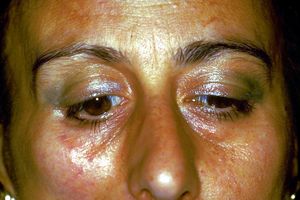










![{\displaystyle \delta _{n}=[0|1]}](https://wikimedia.org/api/rest_v1/media/math/render/svg/cd35df3912a48e5b0b70d9cd5b2e1bee432c3272)
















![{\displaystyle \gamma _{n}=[0|1]}](https://wikimedia.org/api/rest_v1/media/math/render/svg/2f85d0ed73fa3e7903f0321e48668467c1277f4e)







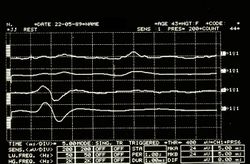

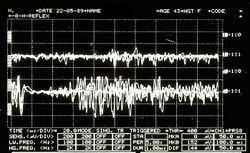
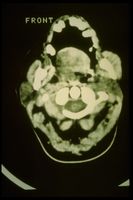



![{\displaystyle \tau =[0|1]}](https://wikimedia.org/api/rest_v1/media/math/render/svg/fbdc534cec0dcf1f070a551e40611eb83e8aca25)














